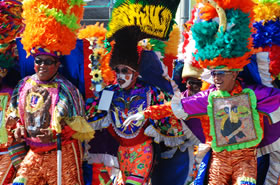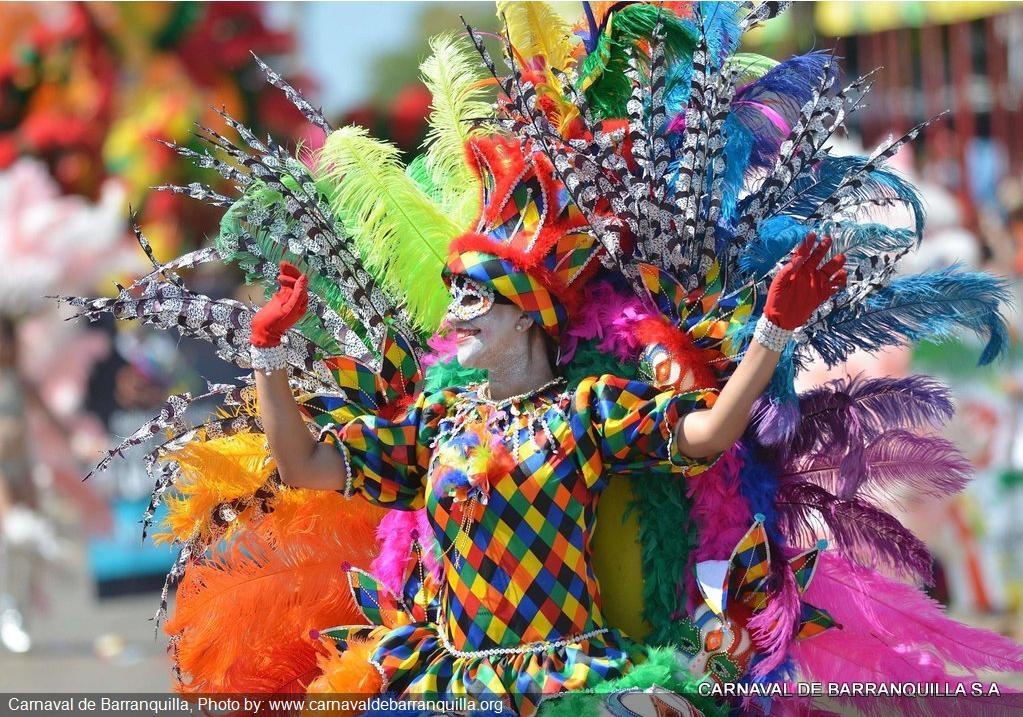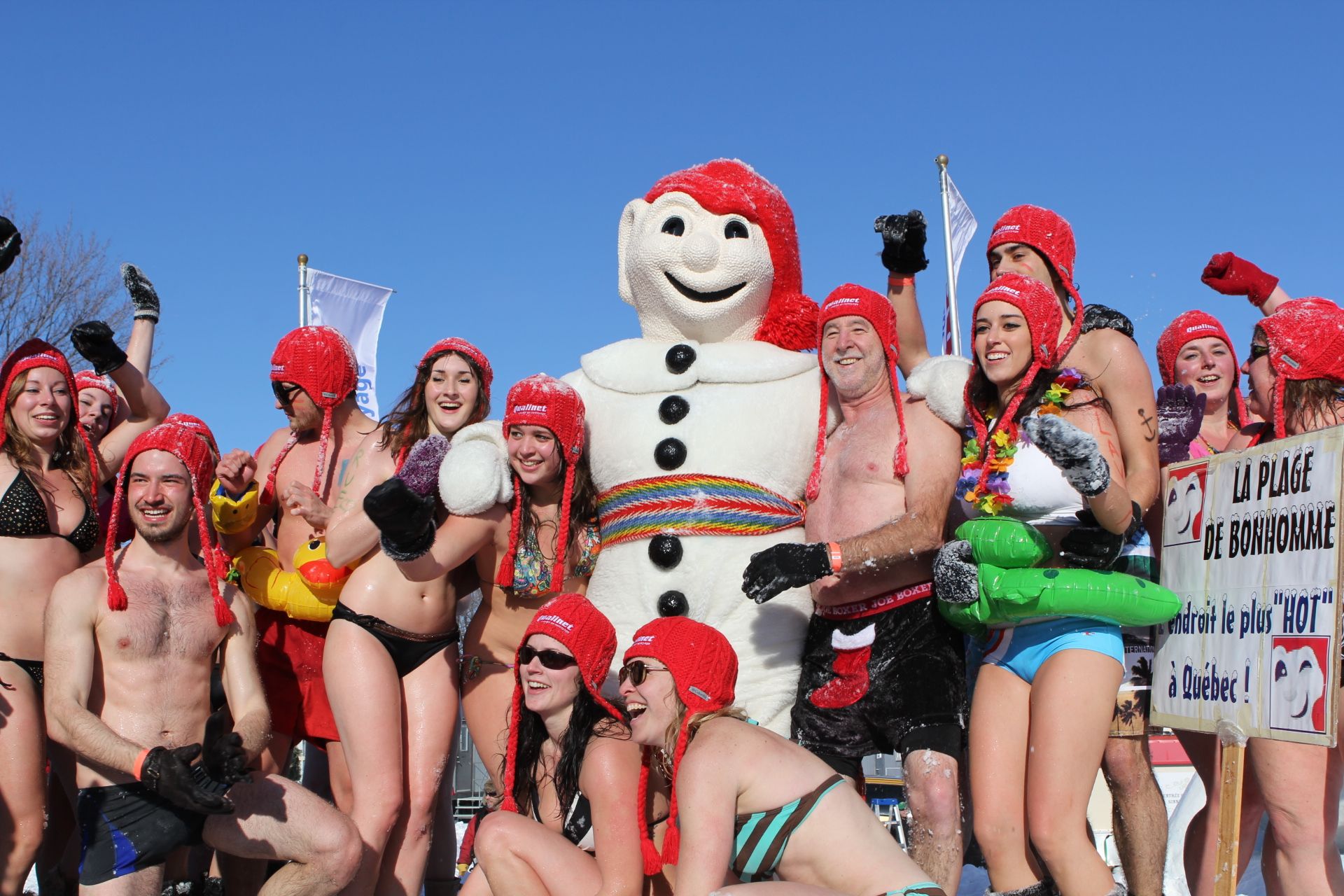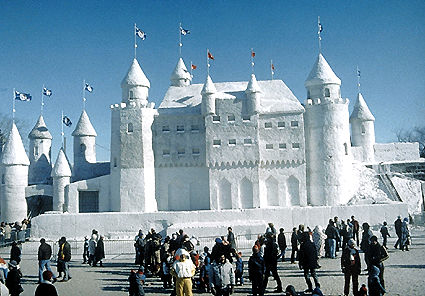CARNIVAL IN AMERICA
South America: Barranquilla Carnival, Colombia
- Place: Barranquilla, Atlántico
- Region: Caribbean
- Date: March 1 - 4
- Duration: 4 days
Origins of the Barranquilla Carnival
It is the best example of a triple cultural fusion (European, African, and Indian) in which the Catholic festivities brought by the Spaniards from the Old World blended with aboriginal ceremonies and the musical heritage of African slaves to become a spectacular folk festivity.

Duration of the Carnival
The Carnival of Barranquilla begins four days before Ash Wednesday and reaches its climax the following Saturday during the Batalla de las Flores (battle of the flowers), where the gaiety and color of the Colombians come face to face in a unique battle of color, flowers, beauty, and peace.
Carnival Days
The carnival takes place over the course of four days. Its most characteristic activities are the following:
Batalla de las Flore
Since 1903, this Battle of the Flowers is the most symbolic of all celebrations, when the first battle took place and the typical carnival characters were incorporated: Rey Momo, María Moñitas, and Hombre Caimán. The Batalla de las Flores is a parade with floats, dance groups, and costumed groups. Among the latter, the following stand out: the marimondas, hooded figures with long noses; and the gigantonas, dwarfs with large heads. The parade is headed by a float from which the queen of the carnival throws flowers while dancing accompanied by a large entourage of princes and princesses.
The Grand Parade
The Desfile de la Gran Parada (the great parade) takes place the following day, Carnival Sunday. The characters are the torito folk dances, the dance ofthe Garabato, and the dances of the hilanderas (spinners).
The two most characteristic dances of this parade are:
- The cumbia, a good example of the fusion of Indian, Black and White elements that simulates a couple courting and is characterized by the elegance and subtle movements of the woman’s hips to the rhythm of a tambora (a kind of drum) and a flauta de millo (a kind of flute).
- The garabato, which symbolizes the victory of life over death.
The 84th Street Parade
The Calle 84 Parade is a big festival that is full of carnival characters and costumes.
This is another party full of groups of people wearing costumes parading through the streets. The main feature of this parade is that the queen of the carnival dresses in black, representing the principal widow of Joselito Carnaval. The queen weeps without consolation until she faints. After this spectacle, dances, costumed groups, and cumbiambas (groups of full of carnival characters and costumes cumbia dancers) reappear to finish off with music and dance to the delight of the numerous public gathered on the sidewalks.

North America: Quebec Winter Carnival, Canada
- Place: Quebec City, Canada
- Region: France
- Begins: End of January
- Ends: Mid February
- Duration: 15 Days
Quebec Winter Carnival History
Among other cultural highlights from their homeland, the habitants of the New France colony brought with them the tradition of getting all the partying out of their system—eating, drinking and being merry—before Lent. In 1894, Québec City held its first large Carnival, but a consistent annual event was interrupted by two wars and an economic crisis before the first official edition of the Québec Winter Carnival took place in 1955.
Since then, many popular events that take place during Carnival seem to be ageless, even if they weren’t part of the festival’s beginnings. Snow sculptures, winter sports, and traditional Québec activities like dogsled and canoe races are beloved highlights of the largest winter carnival in the world.
Carnival Traditions
If you want to get the best of the Québec Winter Carnival , it’s best to learn more about the traditions and symbols that are a huge part of the winter event. First off, find a long, red plastic trumpet (akin to those noisy vuvuzelas that often inspire extreme emotions), employ some more red in your costume, and get an arrowhead sash—a belt worn by Bonhomme Carnaval (the mascot of Carnival season).
Speaking of Bonhomme, he’s the snowman you see in everything that mentions the festival—complete with his half-moon smile, red cap, and arrowhead sash. He’s the personification of the joie de vivre of the winter celebration, and is extremely popular with kids. When he shows up on the first day of Carnival, he’s given the key to the city and is in control until Lent.

Required Viewing of Snow and Ice Sculptures
There are so many pieces to the Québec Winter Carnival that you’re bound to miss something, no matter how hard you try to catch it all. But if you want a short list of things to absolutely not miss, start with the Ice Palace . Built with bricks of compacted snow and lit with colored light displays that make the palace look like an iced dessert, the palace is the center of many Carnival activities. Surrounded by the many snow and ice sculptures carved from blocks of snow by artists from around the world, the palace is the centerpiece of a temporary annual winter wonderland.
A competition hailing from the beginning of Carnival celebrations in Québec, the Canoe Race features several teams paddling on the St. Lawrence River between Québec City and Lévis. Dress warm to watch both the preliminaries and the final, drink some hot Caribou, and you’ll be glad you’re watching and not participating. By all means, stick around in the evening to watch the Night Parades , which take place on the second and third weekend of the Québec Winter Carnival. For some attendees, they’re the best moments of the festival.

Links:
http://en.wikipedia.org/wiki/Carnival#Colombia
http://carnaval.qc.ca/en/
http://en.wikipedia.org/wiki/Quebec_Winter_Carnival
https://www.fest300.com/festivals/quebec-winter-carnival
<>The end... :*)
LINKS:
http://en.wikipedia.org/wiki/Rio_Carnival
http://en.wikipedia.org/wiki/New_Orleans_Mardi_Gras